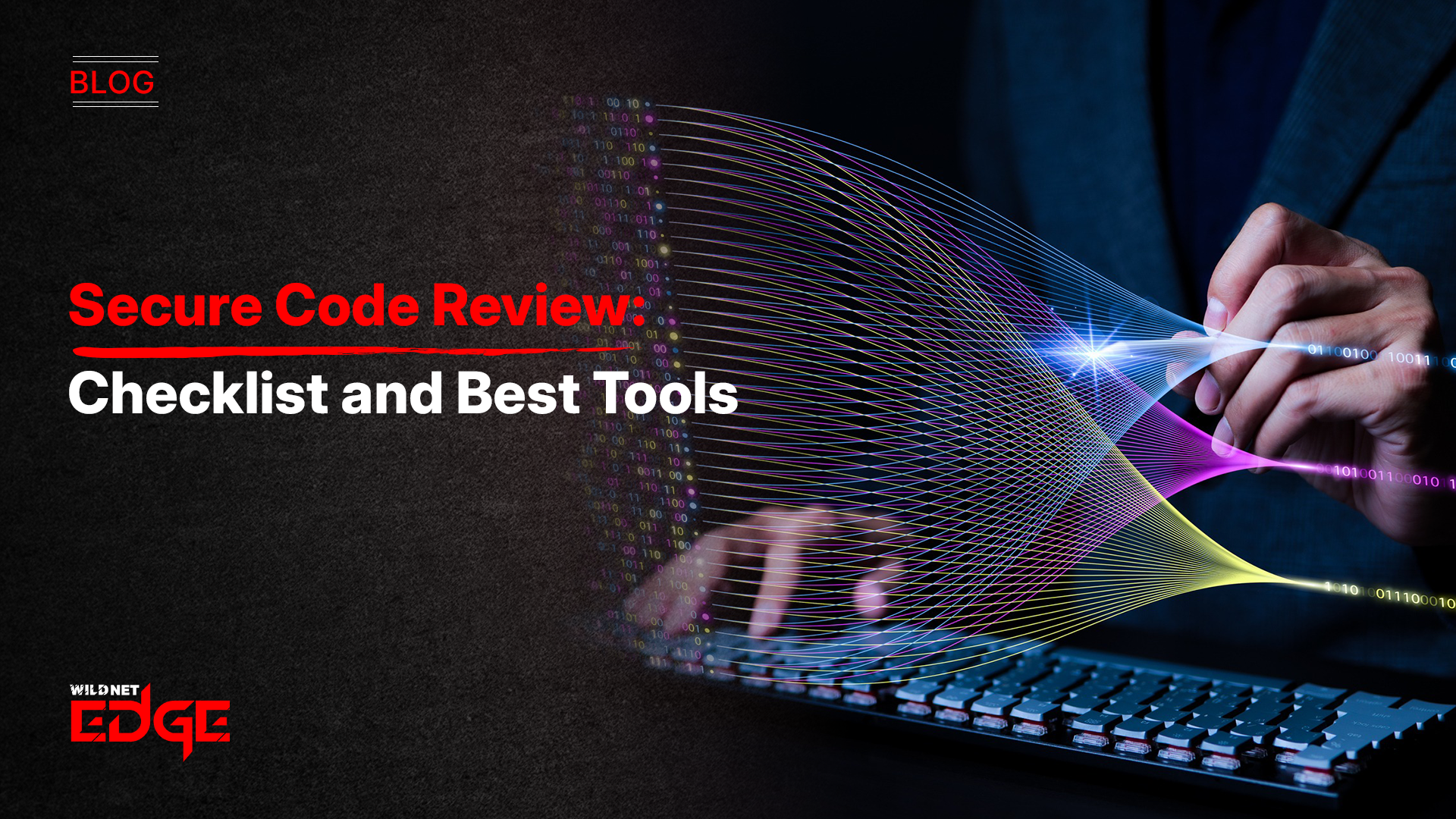TL; DR: The blog post discusses Secure Code Review (SCR) as a vital, proactive method for catching hidden vulnerabilities early in the development cycle. It emphasizes aligning SCR with OWASP Top 10 guidelines and integrating automated secure code analysis tools (like SonarQube) into the CI/CD pipeline (“Shifting Left”). The article provides a detailed secure code review checklist to guide both automated and crucial manual checks. Case studies illustrate how SCR prevents both technical flaws (SQL Injection) and complex business logic errors (Broken Access Control). Ultimately, the goal is to establish security as a foundational development principle, reducing costs and increasing compliance.
Have you ever thought about the reason for the continuous hidden vulnerabilities in your code despite the extensive testing done? Sometimes, it happens because you devote several hours to debugging, only to later come across security flaws. The code review method for security purposes will be your secret weapon that allows you to find such issues very early and avoid your applications from suffering expensive breaches. We will share a convenient checklist with you and the top tools that utilize the OWASP guidelines and static code analysis to make your secure code review invulnerable.
Types of Software Development Where SCR is Crucial
Secure Code Review is imperative in all foremost software development methods, ensuring at the same time that the security is in the product from the very beginning:
- Agile/Scrum: SCR integrates perfectly into the short development sprints so well that it is hard to imagine not having it. Security considerations become a fast, ongoing part of the “Definition of Done,” and thus, minor errors are prevented from turning into serious issues.
- DevOps & CI/CD: SCR plays a vital role here. Vulnerabilities are flagged the instant a developer commits code by embedding automated security scans directly into the Continuous Integration/Continuous Deployment pipeline. This ensures security keeps pace with rapid deployment, making secure code analysis a continuous process..
- Waterfal: In this conventional framework, a formal, extensive SCR is usually performed as a central gate before the testing phase, acting as a last, comprehensive security assurance check.
Stop guessing about security. Implement a definitive software security review checklist today. Connect with us for a comprehensive Secure Code Review strategy session and achieve measurable risk reduction!
Benefits of Secure Code Review
Integrating Secure Code Review (SCR) into your workflow brings many advantages besides finding bugs:
- Cost Reduction: Fixing a vulnerability in the production environment can be costly, up to 100 times higher than fixing the bug during the coding phase. SCR detects the issues early, consequently saving a lot of time and money.
- Enhanced Security Posture: The introduction of security standards such as the OWASP Top 10 through SCR not only allows the elimination of the most prevalent and dangerous vulnerabilities but also reduces the risk of expensive breaches.
- Improved Code Quality: Security practices and good coding practices often overlap. Reviewing code for security also improves logic, maintainability, and overall code quality.
- Regulatory Compliance: SCR helps in proving due diligence and compliance with various industry standards, such as ISO/IEC 27034, HIPAA, and GDPR, which usually mandate verifiable security practices.
Understanding OWASP and Its Role in SCR
The Open Web Application Security Project (OWASP) is a renowned, non-profit organization that is a source of software security worldwide. OWASP guidelines are the primary reference for any secure code review:
- OWASP Top 10: This list prioritizes the ten most critical security risks facing web applications today, e.g., Injection, broken access control, and Cross-Site Scripting. Aligning your software security review checklist with the Top Ten helps reviewers focus on the highest-risk areas.
- ASVS (Application Security Verification Standard): This gives a complete framework for verifying security controls, extending the Top Ten into a detailed assurance checklist.
Popular Technologies & Tools
Manual reviews are crucial but time-intensive. Static Code Analysis (SCA) automates the process by scanning source code without executing it, flagging security flaws and code quality issues. This makes secure code analysis scalable.
| Tool Name | Key Feature | Focus |
| SonarQube | Continuous Code Inspection | Code Quality & Security Hotspots, multi-language support. |
| Checkmarx | AI-Driven Code Scanning | Deep security analysis and vulnerability prioritization. |
| Fortify SCA | Extensive Vulnerability Database | Enterprise-grade, real-time scanning for complex environments. |
| Veracode | Cloud-Based Platform | Automated security analysis and remediation advice for enterprises. |
SCA tools are essential secure code reviewing tools incorporated into CI/CD pipelines, giving developers instant, real-time feedback. Although they are strong tools, they are not foolproof and must be used alongside the experts’ manual reviews in the case of a complicated context or business-logic flaws decoupling.
Secure Code Review Checklist
A well-structured secure code review checklist is vital to consistent and effective secure code review. Use this step-by-step guide to evaluate your code manually and complement automated scans:
- Authentication & Authorization: Find out if the credentials are stored in a strong manner (hashing), session management is secure (non-predictable IDs, short expiry), and the right implementation of Role-Based Access Control (RBAC) has been done to mitigate the risk of privilege escalation.
- Injection Flaws: Check whether or not every user input is treated as a parameterized query or prepared statement so as to be safe from SQL, Command, and LDAP Injection. This is the main area of focus for all the secure coding tools.
- Input & Output Handling: Make sure there is very strict validation on input coming from the server-side (checking data type, length, and format). Use output encoding on all data going to the user interface in order to prevent Cross-Site Scripting.
- Error Handling and Logging: Be careful that none of the error messages exposes sensitive system information, for instance, stack traces. Verify that all the security events that are needed for auditing are recorded in the logs, and that the logs are stored in a secure place.
- Encryption and Protocols: Confirm if all sensitive data transmission is done via modern protocols like TLS 1.3. Verify that data kept on storage is encrypted using strong and current cipher suites and that key management practices observe secure rotation and storage.
Case Studies
Case Study 1: The Bank and the Pipeline
A major regional bank rolling out a brand new, highly sensitive payment API.
Challenge
Their core fear was classic but deadly: SQL Injection. They needed absolute assurance this critical code was safe before it went live.
Solution
We didn’t slow them down; we made security continuous. We integrated Secure Code Review (SCR) directly into their existing build process (the CI/CD pipeline) using SonarQube. It became an automatic gatekeeper.
Result
The very first time the automated checks ran, they flagged over 40 instances of weak input validation! We caught those potential SQL Injection bombs immediately, long before the code was ever merged. That’s security happening at the speed of development.
Case Study 2: The E-commerce Checkout Crisis
A fast-growing e-commerce startup building a new checkout system.
Challenge
They often miss those tricky, logic-based flaws. In this case, there was a risk of Broken Access Control meaning a customer might be able to view other people’s orders just by changing a number in the URL. A nightmare for an online retailer!
Solution
We implemented a focused, manual, expert-led SCR. We had our best analysts dive deep into the specific access control logic of the checkout system.
Result
We successfully uncovered that critical Broken Access Control flaw. We gave the development team precise, immediate advice, and they fixed the issue right away. We eliminated a major vulnerability that would have crushed customer trust, all before the site even launched.
Conclusion
Secure Code Review is an important, proactive defense that helps to prevent attacks. By following the detailed OWASP guidelines and smartly using state-of-the-art secure code review tools for secure code analysis, your team can make sure that security is a principle, not an addition.
Are you prepared to shield your applications with intelligence and efficiency? Contact WildnetEdge now, and let us fortify your security strategy using our AI-first approach to secure code review.
FAQs
Q1: What is the main distinction between SCR and debugging?
SCR is all about eliminating security vulnerabilities and weaknesses, taking preventive measures, whereas debugging is concerned with locating and rectifying functional logic errors
Q2: How often should secure code reviews be conducted?
In modern development (DevOps/Agile), continuous secure code analysis should be performed along with every code commit. A complete, expert-led manual review should be conducted at least once for every major release.
Q3: What do you mean by “false positives” related to static analysis?
False positives refer to issues that are not vulnerabilities but are flagged by the automated SCA tool as security weaknesses. Only an expert review can help filter these out and concentrate the development effort on the actual risks.
Q4: Will the security team still be needed if SCR is performed?
Definitely not. SCR is a method that both the security and development team can utilize. It is a plus to the skilled-security- professionals- needed-for-manual-analysis-and-threat-modeling.
Q5: What does ‘Shifting Left’ mean in SCR context?
Shifting Left suggests that security actions like code scanning and reviewing are done at the very first stage (on the developer’s desktop or in the CI/CD pipeline) instead of waiting till the last stage of the development cycle.

Nitin Agarwal is a veteran in custom software development. He is fascinated by how software can turn ideas into real-world solutions. With extensive experience designing scalable and efficient systems, he focuses on creating software that delivers tangible results. Nitin enjoys exploring emerging technologies, taking on challenging projects, and mentoring teams to bring ideas to life. He believes that good software is not just about code; it’s about understanding problems and creating value for users. For him, great software combines thoughtful design, clever engineering, and a clear understanding of the problems it’s meant to solve.
 sales@wildnetedge.com
sales@wildnetedge.com +1 (212) 901 8616
+1 (212) 901 8616 +1 (437) 225-7733
+1 (437) 225-7733































